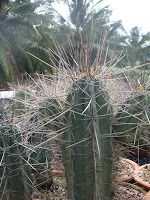บ้านแพ้วแคคตัส
คุณชิงชัย (คุณเช็ง)
มี Pachypodium ขนาดใหญ่ จำนวนมาก
สำหรับจัดสวน
089 6964347
ร้านค้า สนามหลวง 2
| สวนบ้านคุณเช็ง ถ้าให้มาเองคงมาไม่ถูก
|
| ปลูกผักปลอดสารด้วย หุหุ...
จะเห็น ความเป็นระเบียบของสวนพี่เช็ง จากที่พาชี่ยืนเรียงตามลำดับความสูงเลย
ส่วนห้องเล็กที่อยู่ไกลออกไปนั้น เวลานั้นเป็นห้องว่าง
แต่อีกซักพักจะความวุ่นวายขึ้นที่ห้องนั้น
(ดูได้จากกระทู้นี้ คห8 เลยครับ อิอิ)
เอ [16 ก.ย. 2551]
|
ที่นี่ ท่านจะประทับใจกับบรรยากาศสวนมะพร้าว ที่พบได้แถบบริเวณนี้
แต่ที่สวนนี้ มีสวนกระบองเพชร ล้อมรอบ สวนมะพร้าว
การดูแลเอาใจใส่ที่ดี ทำให้ต้นไม้ธรรมดา ๆ
ที่เราเราท่านท่าน มักจะมองผ่านไป ได้แสดงความสวยงามและน่าสนใจของตัวเองออกมาอย่างเด่นชัด
|
พาเที่ยวกันต่อนะครับ ขอขึ้นกระทู้ใหม่ก็แล้วกัน
พี่เช็งเจ้าบ้านก็นำ มะพร้าวเผา
และน้ำตาลสดมาต้อนรับ ton_oak [16 ก.ย. 2551]
|
จากนั้นก็พาชมสวนครับ
เดินลัดเลาะตามคันดินในสวน
สนเจอของแปลก
พาคีโพเดียมลงดิน เหมือนปลูกผักเลยครับ ton_oak [16 ก.ย. 2551]
|
|
แคคตัสก็ลงดินเช่นเดียวกัน ton_oak [16 ก.ย. 2551]
| ........
|
|
เยอะมากครับ ต่อไปคงเป็นป่าไม้หนามได้เลยล่ะ ton_oak [16 ก.ย. 2551] |
จากนั้นก็กลับมาเดินดูไม้กันครับ ton_oak [16 ก.ย. 2551]
|
|
ใครเหนื่อยก็นักพักศาลาริมน้ำ ton_oak [16 ก.ย. 2551]
|
ใครยังไหวก็ช็อปกันต่อ ton_oak [16 ก.ย. 2551]
|
|
ใครเสร็จแล้วก็แพ็คของ ton_oak [16 ก.ย. 2551]
หลังจาก ทุกท่านเดินเลือกดู/ซื้อไม้ตามที่ชอบแล้ว
เกิดไทยมุงขึ้นกลุ่มนึง มามุงดูไม้ที่เพื่อนร่วม trip เลือกมา
แลกเปลี่ยนความเห็น
มาแอบลุ้นกันว่าพี่เช็งจะกรุณาให้พากลับบ้านมั้ย
หลังจากนั้นก็เกิดอาการ 'ทรัพย์จาง' กระทันหัน
พร้อมกับมีกล่อง/ถุงบรรจุต้นไม้ติดมือกัน ไปคนละนิดละหน่อย เอ [16 ก.ย. 2551]
|
จากนั้นคุณอาร์ตก็เป็นตัวแทนกล่าวขอบคุณเจ้าบ้าน ton_oak [16 ก.ย. 2551]
|
| และก็มาแวะรับประทานอาหารครับ
นี่เป็นบรรยากาศข้างร้านศรีสุวรรณ
|
|
| แขนงน้ำมันหอย
| กุ้ง...อะไรซักอย่าง ton_oak [16 ก.ย. 2551]
พี่เช็งบอกว่าเมนูนี้ชื่อ กุ้งชาววัง
เป็นเมนูขึ้นชื่อของร้านนี้
เห็นแล้วหิวขึ้นมาเลย
เอ [16 ก.ย. 2551]
|
|
เปรี้ยวหวานครับ
ton_oak [16 ก.ย. 2551]
|
หมดแล้วครับ ขอบคุณทุกๆท่านที่ติดตามชมนะครับ
ไว้เจอกันโอกาสหน้าครับขอบคุณอาเป้ามากๆ ครับ ที่จัดกิจกรรมสนุกๆ แบบนี้ให้พวกเรานะครับ
|
Garden design is the creation of plans for layout and planting of gardens and landscapes. Garden design may be done by the garden owner themselves, or by professionals. Most professional garden designers are trained in principles of design and in horticulture, and have an expert knowledge and experience of using plants. Some professional garden designers are also landscape architects, a more formal level of training that usually requires an advanced degree and often a state license. Elements of garden design include the layout of hard landscape, such as paths, rockeries, walls, water features, sitting areas and decking, as well as the plants themselves, with consideration for their horticultural requirements, their season-to-season appearance, lifespan, growth habit, size, speed of growth, and combinations with other plants and landscape features. Consideration is also given to the maintenance needs of the garden, including the time or funds available for regular maintenance, which can affect the choices of plants regarding speed of growth, spreading or self-seeding of the plants, whether annual or perennial, and bloom-time, and many other characteristics.
The most important consideration in garden design is how the garden will be used, followed closely by the desired stylistic genres, and the way the garden space will connect to the home or other structures in the surrounding areas. All of these considerations are subject to the limitations of the budget. Budget limitations can be addressed by a simpler garden style with fewer plants and less costly hardscape materials, seeds rather than sod for lawns, and plants that grow quickly; alternately, garden owners may choose to create their garden over time, area by area.
[edit] Elements of a garden
A garden is a planned space, usually outdoors, set aside for the display, cultivation, and enjoyment of plants and other forms of nature. The garden can incorporate both natural and man-made materials. The most common form is known as a residential garden. Western gardens are almost universally based around plants. Zoos, which display wild animals in simulated natural habitats, were formerly called zoological gardens.[1][2]
See traditional types of eastern gardens, such as Zen gardens, use plants such as parsley. Xeriscape gardens use local native plants that do not require irrigation or extensive use of other resources while still providing the benefits of a garden environment. Gardens may exhibit structural enhancements, sometimes called follies, including water features such as fountains, ponds (with or without fish), waterfalls or creeks, dry creek beds, statuary, arbors, trellises and more.
Some gardens are for ornamental purposes only, while some gardens also produce food crops, sometimes in separate areas, or sometimes intermixed with the ornamental plants. Food-producing gardens are distinguished from farms by their smaller scale, more labor-intensive methods, and their purpose (enjoyment of a hobby rather than produce for sale).
Gardening is the activity of growing and maintaining the garden. This work is done by an amateur or professional gardener. A gardener might also work in a non-garden setting, such as a park, a roadside embankment, or other public space. Landscape architecture is a related professional activity with landscape architects tending to specialise in design for public and corporate clients.
The term "garden" in British English refers to an enclosed area of land, usually adjoining a building.[3] This would be referred to as a yard in American English. Flower gardens combine plants of different heights, colors, textures, and fragrances to create interest and delight the senses.
































1 comment:
nice blog
i like cactus ,good luck
Post a Comment